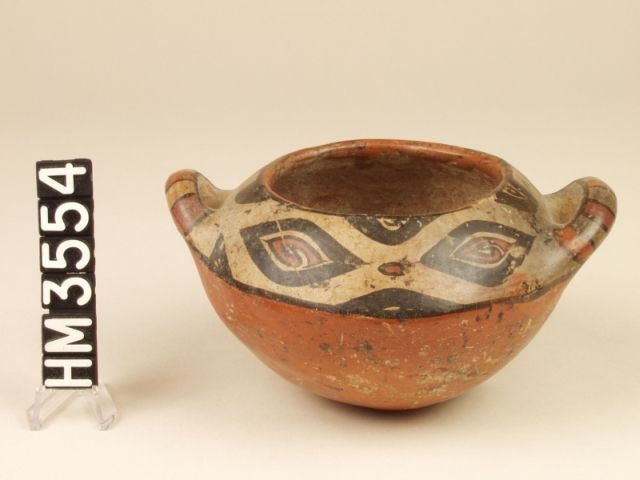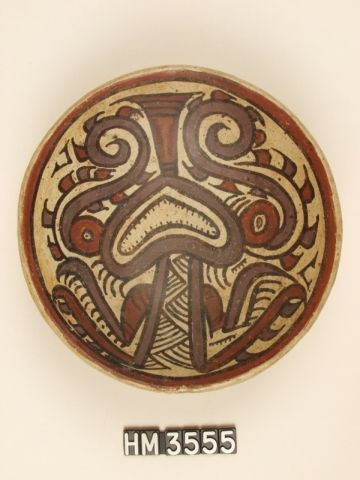Boa & Iguana
The images delineated by color on Panamanian ceramic wares are frequently in the form of various animals of land or sea or air that were associated with concepts regarding cosmological origins. The most widely used motif, and probably one of the most fundamental symbolic figures, is the serpent. The Giant Snake is a major creature in the lore of Tropical America in general, where, as Rainbow Serpent or Plumed Serpent, it is associated with a range of phenomena including sexuality, immortality, sun or water, and the establishment of human and animal identity. In the lore of Talamancan tribes of southern Costa Rica, at the time of the origins of the world a great serpent with long whiskers lived below the East, where the sun rises.
Among Mesoamericans, the rattlesnake represented the cosmological Great Snake; in Amazonia, the anaconda. In the isthmus of Panama the boa constrictor was the zoological expression of the Great Serpent. Since the boa is a strong swimmer, is found in the forests, and inhabits the branches of trees, it is also an excellent example of an “anomalous” creature that, contrary to ordinary animals, combines all the domains of the universe in it’s habits and thus unifies the cosmos. Such animals are accorded great symbolic weight and ideological power. The boa, like all serpents, also is devoid of appendages, and thus appears as simply a great undifferentiated, undulating length of dynamic life, the essence of pure and primordial life energy.
Some pieces of Panamanian ceramic art depict in a very realistic form the distinctive diagnostic markings of the boa constrictor, a series of ovals and concave rectangles that are repeated along the body of the serpent. Other designs depict boa markings by various kennings (short-hand abbreviations). Most common here are repeated sets of parallel lines, one set of lines drawn horizontally, the other vertically, that represent the oval-rectangle sequence. Other variations on this pattern occasionally occur. The boa constrictor as Great Snake may also be referenced in design by depicting a distinctive open mouth with teeth and eyes with stripes (the boa constrictor had distinctive eye stripes on each side of the head). The presence of a tongue may refer to the serpent but usually refers to another animal theme. Boa ovals, or their equivalent in design form, are sometimes depicted as containing a creature or an animal may be shown emerging from a boa oval, suggesting a connection between boa ovals and the concept of the fertilized egg, a very fundamental cosmological belief among many Tropical American peoples.
Panamanian art sometimes depicts the serpent by itself. Usually, however, serpent-related depictions show a creature with added appendages, such as claws or limbs or headcrests, that indicate that although the animal depicted has its own identity it also inherently contains the essence of the serpent; in other words, the animal is, essentially, a “serpent plus appendages”. One of the most frequent encountered Panamanian designs depicts a composite figure incorporating the theme of the boa as part of a limbed and clawed creature, often with a headcrest and, sometimes, a thick protruding tongue. Some depictions of this figure also portray the eye of the creature as an oval with a horizontal slit. These characteristics suggest that the animal is an Iguana, and imply that the iguana had symbolic relevance.
A variety of iguanas are common in Panama and the figure depicted on ceramic art may combine attributes of several zoological species. The large common iguana has a row of spines down the length of its back and has a thick, somewhat protruding tongue and a noticeable dewlap. More importantly for iconographic depictions, its eyes when closed appear as ovals with horizontal slits. (Boa eyes, in contrast, reduce to vertical slits, as do the eyes of crocodilians). Basilisk iguanas, another common iguanid in Panama, are characterized by distinctive head crests and (sometimes) back and tail crests.
Composite “Iguana-boa” figures in ancient Panamanian belief may have filled symbolic positions usually attributed to crocodilians in Mesoamerican and Amazonian lore as a creature associated with primordial origins. Indeed, a tale from the Talamacan Indians of Costa Rica describes how the crocodile was superseded by what appears to be the iguana; briefly, in primordial times the creator deity became annoyed at the unruly behavior of the crocodile, who then had a beard and a long tongue with which it would catch people. To punish the crocodile the deity had it’s tongue and it’s beard removed and given to the sun to make its rays.
Although the tale does not identify the iguana explicitly, the image of the sun as a tongued and bearded (dewlapped) being may imply a solar-associated iguana. This identity would have a basis in iguana behavior. The common iguana may easily appear to have a particular solar or celestial association given that it practices thermoregulation, requiring it to bask frequently in the sunshine. The iguana (like the boa) is also an anomalous creature that frequents the branches of trees along waterways, lays its eggs in burrows dug on land, and frequently falls into water to escape danger. Basilisk iguanas are also frequently seen in bushes along waterways or at the edge of the seashore and are famous for their ability to walk as well as swim across water. This capability is highlighted in a story from the Kuna Indians of Panama which recounts how, in mythical times, the basilisk iguana introduced cooking fire to human beings by carrying a glowing coal in its head-crest as it swam across a river separating the world of animals, the original owners of fire, from the world of people, who henceforth would have fire.
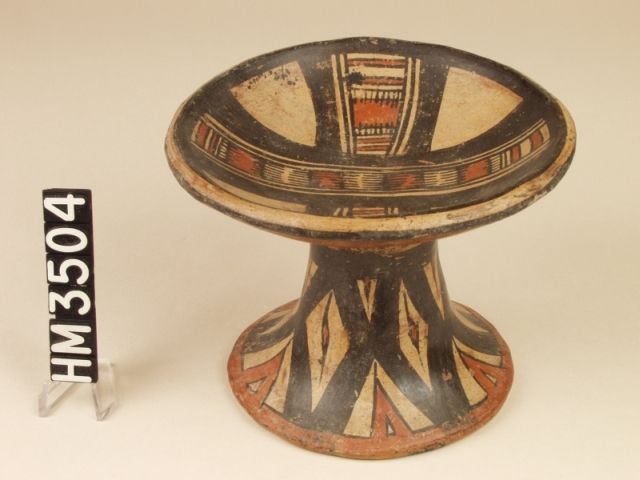
Polychrome Ceramic Pedestal Plate
A.D. 800-1000
Macaracas (Late Coclé) Period
Pica Pica Variety
![Polychrome ceramic plate Decorated in quadrants, each depicts a crested, curly-nosed iguana [see alternate description below], identified as such particularly by the horizontal eye slit and clawed limbs. Distinctive eye stripes indicate the theme of boa constrictor, frequently paired with the iguana. The rim pattern suggests the oval-rectangle sequence of markings on boa constrictors.](https://umaine.edu/hudsonmuseum/wp-content/uploads/sites/275/2013/01/hm3530.jpeg)
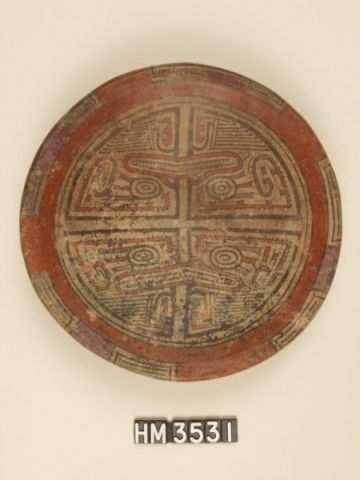
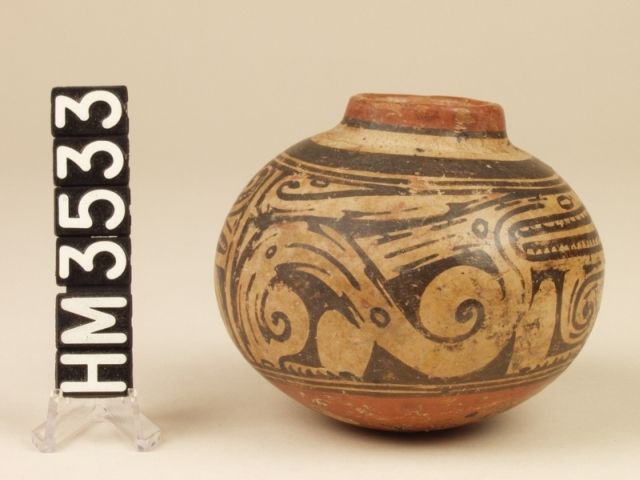
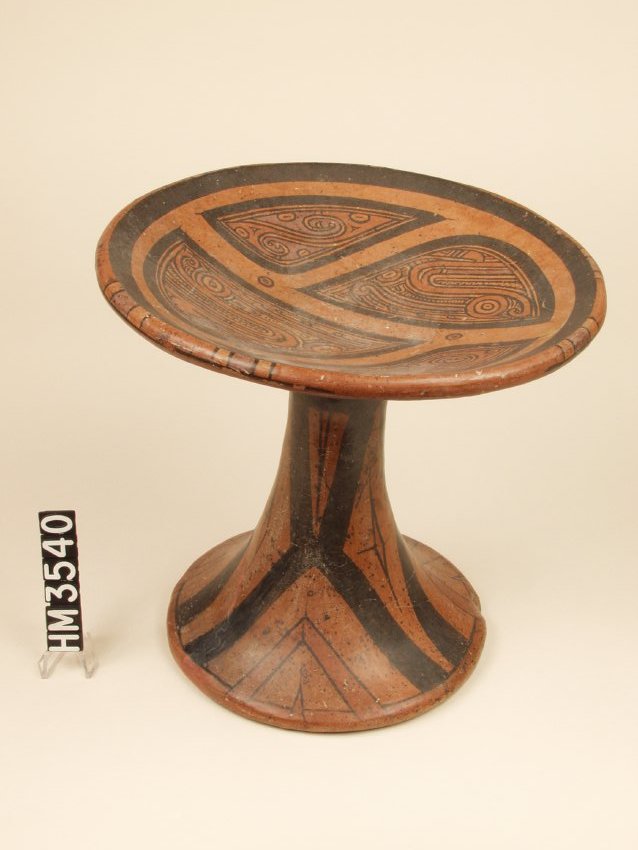
Polychrome Ceramic Pedestal Plate
A.D. 800-1000
Macaracas (Late Coclé) Period
Veraguas Pica Pica Variety
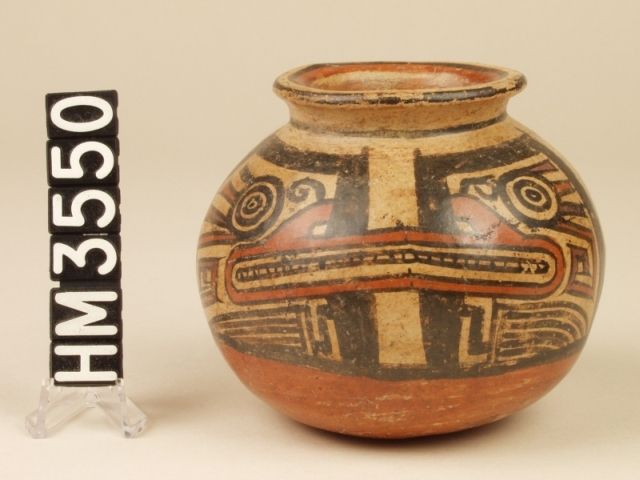
Polychrome Ceramic Rounded Jar
A.D. 800-1000
Macaracas (Late Coclé) Period
La Peòa, Veraguas Pica Pica Variety
